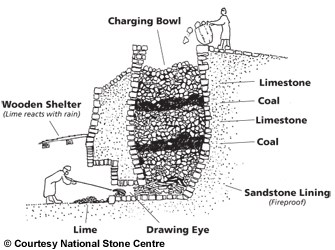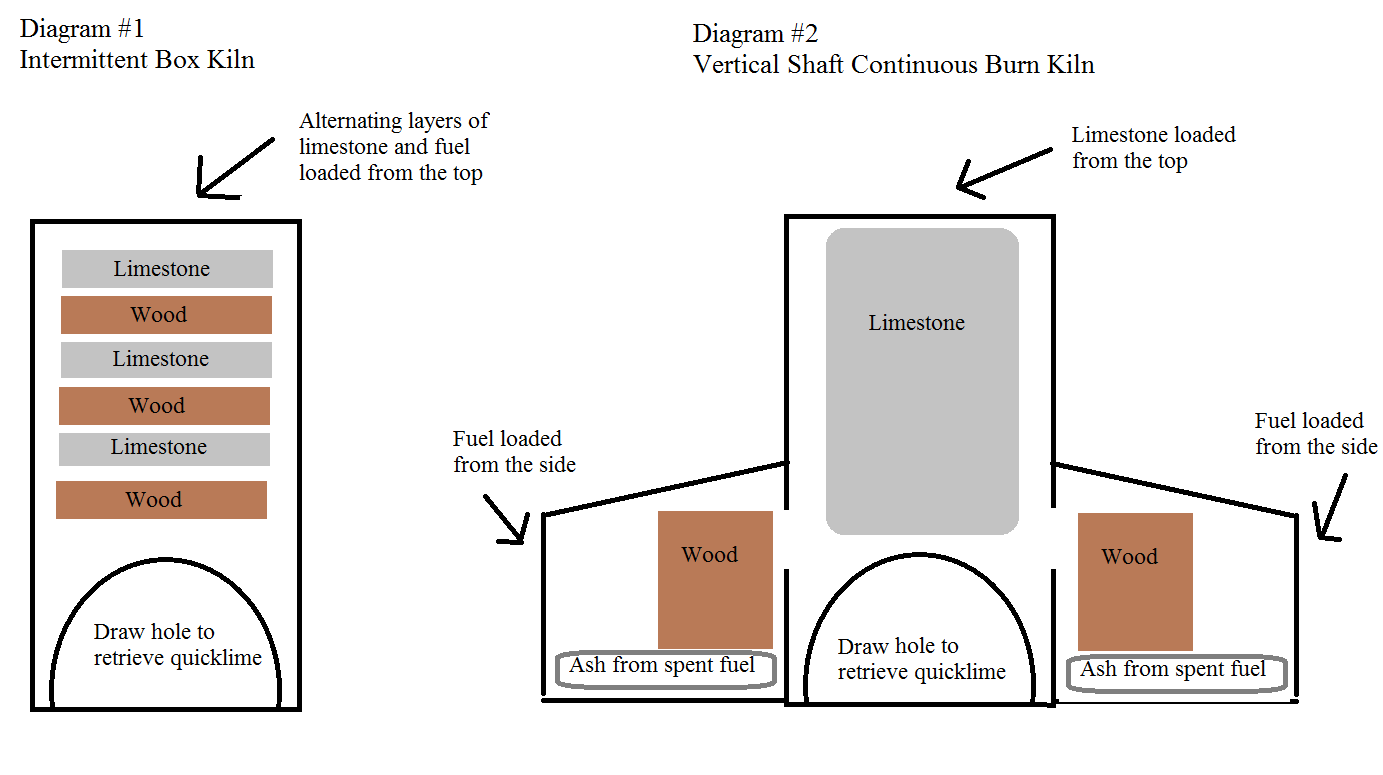This earthcache is located at Fountain Rock Park & Nature Center.
The park and nature center hours are as follows:
Park Hours
Year Round
8 a.m. - Sunset
Nature Center
Walk-Ins / Public
Saturdays: 10 am - 4 pm
Sundays: 1 - 4 pm
Going to the nature center is not required for this cache. The above info was added just for anyone who may need it. You can go directly to the kilns when going for this cache.

The lime kilns are a short walk from the parking coordinates. When visiting the kilns there is a small self guided trail around 6 of the original 8 kilns.
For your safety and for the protection of the site, please stay on the walkways. Do not go into or climb onto the structures.
Just before the kilns you should see a sign that has a map of the location of 9 interpreitive signs which explains the sites features.
Before your eyes you will see 6 of the orignal 8 kilns. The other 2 were never used as they were considered unstable and now have collapsed.
The Property
100 years ago limestone quarrying was an important industry in Frederick County because of the rich limestone fault that runs under the entire county. From examining the deeds recorded on the Fountain Rock Park property, it is evident that the land was used extensively for this industry. It has not been determined in exactly what year the kilns were built, but it is known that on November 18, 1907, it was referred to as the Fountain Rock Lime Company.
Leonard Barrick bought Fountain Rock in 1907, as a supplementary limestone quarry to the Barrick Woodsboro plant, which he started in 1874. His family said that Fountain Rock Spring was not profitable (there were not enough kilns), so he sold it to Stoner and Powell.
History
The Fountain Rock Quarry and lime kilns operated between 1872 & 1955 producing two major products, powdered burnt line for agricultural use and crushed stone for road surfacing. Most of the original structures and equipment are gone, but remnants of both crushed stone and powdered lime operations have survived including six of the eight kilns. These kilns are also referred to as continuous burning pot kilns. During World War II, since manpower was in short supply, some German and Italian prisoners of war were brought to Fountain Rock Park daily by bus to provide labor.
Nearby Rail Road
The railroad, bordering the south side of the park, was constructed in 1872, and was utilized in the lime industry.
The Geology of Limestone
Limestone is a sedimentary rock (laid down in layers over time), composed of the element calcium carbonate (CaCO3). imestone is primarily comprised of the shells of sea creatures that were crushed and solidified, trapping carbon dioxide in the process. This is why when limestone is heated (calcination), to temperatures of between (402-898°C), carbon dioxide is released. The remaining product is then called quicklime. Quicklime combined with water produces slaked lime and hydrated lime (Ca[OH]2). Historically, lime was used by farmers in fertilizing fields and increasing crop production. Lime neutralizes acidic soil. But more importantly, lime was used in mortar for building. These days lime is used in the steel, pulp and paper, and mining industries as well as for water and sewage treatment and removal of sulphur dioxide from smelter-stack gases and thermal power-plant emissions. Kilns were built on the side of a small hill or knoll and lined with refractory (heat resistant) stones, such as sandstone and then laid in mortar. Later refractory bricks were used to line the kilns. Kiln shape and size was pretty much standard for efficiency. Most kilns were between 7 - 13.5 feet in diametre but varied in depth. They were loaded from the top with layers of limestone and wood or limestone and coal. When loading was complete, the kiln was fired at the bottom, through an opening called an "eye", and the fire gradually spread upwards through the charge. When burnt through, the lime was cooled and raked out through the base. Fine ash dropped out and was shoveled away. 
Fist-sized lumps of limestone had to be thrown by hand into the top of the kiln. Only lumps could be used, because the charge needed to "breathe" during firing. Because of this, the size of kilns were pretty much standard. Anything over 8 feet in diameter was not efficient as the half-burned charge would be likely to collapse under its own weight, extinguishing the fire. Kilns always made 25–30 tonnes of lime in a batch. Typically the kiln took a day to load, three days to fire, two days to cool and a day to unload, so it was a one-week job of manual labour and 24-7 monitoring for a group of men. The workers would camp out by the kiln, risking the danger of burns, or even rolling into the kiln while sleeping and burning to death. Firing the kiln was dangerous. The caustic gases emitted could burn the skin and eyes. Producing a good batch of quicklime was usually a trial and error production as the amount of wood or coal would vary from batch to batch. Efficiency was affected by many factors including temperature differences between the centre of the charge and the material close to the sandstone or brick walls, as well as the amount of underburned versus finished quicklime. In this antiquated kiln, the lime would also get adulterated with ash from the burned wood and be less "pure".
Chemistry in the Kiln
During a burn, temperatures inside each kiln reached 1500º - 1700º Fahrenheit. The high heat chemically changed the limestone. Once the limestone had been burned, the result was called quicklime.
CaCO3 + Heat -> CaO and the process releases CO2.
Quicklime can be combined with water to produce slaked lime (Ca[OH]2). Slaked lime reduces the acidity of soil, improves water penetration, and provides asource of calcium magnesium for plants.
Types of KIlns
Intermittent Box Kiln
In an intermittent box kiln, limestone and wood were loaded from the top in alternating layers and then ignited from below (see diagram #1). The kiln burned for several days. During the burning process, workers would try to keep the temperature uniform. This was accomplished by piling up dirt or debris to regulate the draft. When the burning was completed, the kiln was then cooled for 2 days before being unloaded and repaired. The lime was raked out of the bottom along with ash. The use of this type of kiln fell out of favor as more efficient kilns were built.
Vertical Shaft Continuous Burn Kiln
A vertical shaft continuous burn kiln could be used non-stop and didn't require nearly as much maintenance as an intermittent box kiln. In this type of kiln, the limestone is loaded from the top and the fuel is loaded from the sides (see diagram #2). This had the added benefit of reducing the amount of ash that would be mixed in the quicklime. Temperatures inside the kiln could reach over 1832º F (1000º C). Fire brick was used inside the stack to prevent the structure from crumbling due to the continuous high heat. Four acres of trees were needed yearly to fuel one vertical shaft continuous burn kiln. One kiln could produce around 6,000 bushels of high quality lime over the course of a year.

HOW TO CLAIM A FIND
E-Mail me the answers to the following questions:
1. The walls of the lime kilns are comprised of what material?
2. Why do you think the kilns were built on the hillside?
3. What is the diameter of the kilns?
4. The transformation from limestone to quicklime had several benefits. What are they?
5. Why do you think this is a good area to build lime kilns?
My email is vincepuccini@gmail.com
Optional:
Post a photo of yourself in front of the lime kilns.
References:
https://ballincollig.wordpress.com/limekilns/
https://www.recreater.com/299/Lime-Kiln-History
https://s3.amazonaws.com/gs-geo-images/df17bc0b-b244-4bfa-b115-b5bc90b12240.png
Thank you
The self guided tour was made possible through the generous donations of:
Maryland Parks Foundation
S.W. Barrick & Sons